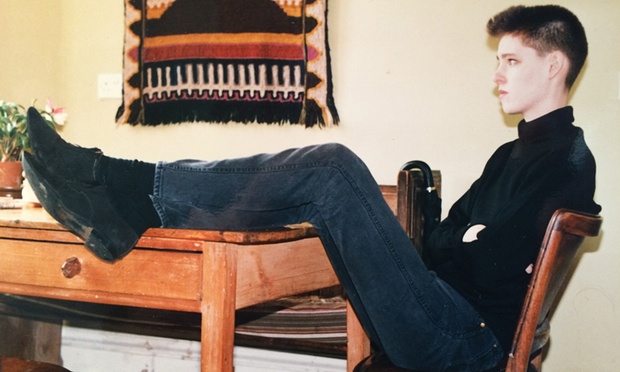



Jes Fernie in Edinburgh in 1986 with flattop haircut and winklepickers. Photograph: Courtesy Jess Fernie
Jes Fernie
AS a teenager, I lived on a prostitutes’ beat. Walking home in my school uniform was an exciting affair. I wasn’t in the slightest bit sexy – I attracted a niche market of desperate men looking for absurdly tall, spotty women dressed as schoolgirls. I never felt remotely threatened. The drivers were profusely apologetic when I explained that I was walking home from school.
As a 6ft 2in woman, I have been able to monitor, on a daily basis, the extent of society’s limited parameters of what it is to be female. Now that my daughter is fast approaching my height, I am looking at the situation anew, scratching around for any signs of progress. Will she be called “sir” with the regularity of a finely tuned clock? Will she be mistaken for a transvestite and nearly beaten up in a dark Manchester side street? Will she be offered sex in Soho (“Looking for a good time, mate?”) or be asked if she is a model (“A model what? A model citizen? Certainly not an aeroplane”). Will she have to cross to the other side of the road late at night when walking behind a woman who thinks she is a man? (The mental gymnastics!)
But let’s go back a bit. It is 1985. I am 15 and living in Edinburgh. I walk into a barbershop and take my place in a row of men and boys waiting to be shorn. When my turn comes, I ask the slightly ageing barber to give me a flattop (all the rage in those days among the boys). I am pretty certain he has never cut a girl’s hair, but I am also pretty certain he doesn’t know I am a girl. I am wearing a black poloneck jumper, black jeans and smart black suede winklepickers. I have no boobs and no hips. When he is finished, I look like a pencil. I look incredible. Something neither male nor female; a pale, sullen, chisel-boned, androgynous entity. It was clear to me then that my experience of being female was in direct contrast to almost every female around me.
Every bit of social cueing pitched me as an aberration. Every film I had seen, every advertisement, every relationship I witnessed, taught me that the natural order of things is that a woman looks up to a man. This relation of small to tall is so elaborately enshrined in the minutiae of daily life that it is pretty hard to unravel. It sets up a pattern of well-honed oppositional binaries: protector/ protected, masculine/feminine, powerful/powerless. It dictates who we are attracted to, and how our fantasies are constructed. The archetypal photo of a male-female couple (his arm around her, her head nuzzled against his chest) speaks volumes about the strict code of behaviour expected of each sex.
Advertisement
I realised early on that this fantasy was not an option for me. So I pushed it to its logical conclusion – and assumed the guise of a man who looked as if he needed sex in Soho (not just a woman who looks like a man, but a desperate man). I comforted myself with the thought that if I looked like a man, at least I looked like the kind of man that I fancy – fine boned, effeminate, a bit gay. I developed a character that reflected my look: obstreperous and opinionated.
Needless to say, my boyfriends had to buy into this identity in some way. By then, I had started to wear short skirts and lipstick (hence the transvestite incident), but some days I just couldn’t face the cat-calling or the leering. Then, I would wear jeans, and sod it if my boyfriend and I were mistaken for two gay guys holding hands. It is extraordinary, waking up each morning and deciding whether I want to be thought of as gay man or leggy woman that day. It would be liberating if it were not so depressing.
The first boyfriend I lived with, after graduating and moving to London, happened to have the same name as me (we can add narcissism to that list of characteristics). I had lopped the second “s” off my name, Jess, when I was 10, after deciding that an “s” was an “s”, so why did I need two? Later, it seemed that this was only half the story. I wanted to mess with expectations and gender roles, and create confusion on paper as well as in person.
When I had my first child, I gave her a boy’s name (which turned out to be the name of a famous female porn star as well). My partner and I were primarily looking for a name that didn’t end with a diminutive vowel sound; we wanted a name with a bit of oomph that ended in a consonant.
I am aware that throughout her and her brother’s early childhood, the only time they got to see tall women in films or read about them in books was when there was a requirement for an overbearing, physically aberrant, barren and untenable character. That, or a seriously sexy dominatrix. Think Miss Trunchbull in Matilda, and Jessica Rabbit. Now that the kids are older, it has become more subtle with comedians such as Miranda Hart assuming the mantle of gawky, socially inept, single (hilarious) buffoons.
Female politicians such as Angela Merkel and Theresa May are regularly depicted in political cartoons as monstrous creatures, looming over their male counterparts with their barren wombs threatening the status quo. It seems a bleak, intensely unimaginative place in which to grow up and test out ideas about who you are and what type of space you would like to claim in the world.
The aggression that is levelled at girls and women who dare to raise their voice on public platforms tells us that not much has changed and, if anything, it may be getting worse. Market forces and the wide availability of a particular type of vicious, misogynistic porn have clubbed together to create an even bigger pool of girls and boys who aspire to conform in order to gain social acceptance. Sometimes, it feels as if our understanding of each other’s sex has narrowed to the point of oblivion.
But as this pool of conformity and fear grows, so too, it seems, does the smaller oppositional pool of freakery and bolshieness. Popular social commentators and writers such as Caitlin Moran and Laurie Penny sound a claxon to their ever-increasing female and male fan base: “Fuck the status quo. Bring on the revolution!” And then, a man with a beard, dressed as a woman, wins the Eurovision song contest and I am told in admiring tones three times in the space of as many weeks that my daughter looks like a cross between David Bowie and Tilda Swinton, or (even better) the bastard child of David Bowie and Tilda Swinton – and I realise there may be hope.
The more women are able to create their own social position, achieve high educational goals and earn a decent living, the further we move from a conventional understanding of the power dynamics in relationships, including expectations about height.
While concepts such as “marrying up” or “marrying down” are still prevalent, they are increasingly being challenged or dismissed (let’s think of this “up” and “down” in relation to physical stature as well as financial and class-based hierarchies). There are lots of examples in recent years of women choosing to be with men much younger than themselves (notably, Swinton), or men who choose to be with women more financially successful than they are. And there are even increasing numbers of men whose partner is taller than they are, although research shows that the number is not increasing significantly.
I recently found out from a relative in Australia that, at the age of 25, my great aunt dug a hole on Cottesloe Beach, Perth, buried her dress in the sand, and assumed the identity of a man. She changed her name from Margaret Bale to Martin Able and took a series of men’s jobs including bar steward, “strong boy and cellarman”, political canvasser and factory worker.
There was an article in the Perth Daily News (6 August 1910), entitled “The disguise of sex”, which detailed the escapades of a woman in search of more options. Apart from sounding like a Sarah Waters novel in the making, the story is spookily prescient. What would Margaret/Martin make of my dalliance with gender bending? And how much has changed since she buried those clothes?-theguardian.com
![]() Follow us on Twitter on @FingazLive and on Facebook – The Financial Gazette
Follow us on Twitter on @FingazLive and on Facebook – The Financial Gazette